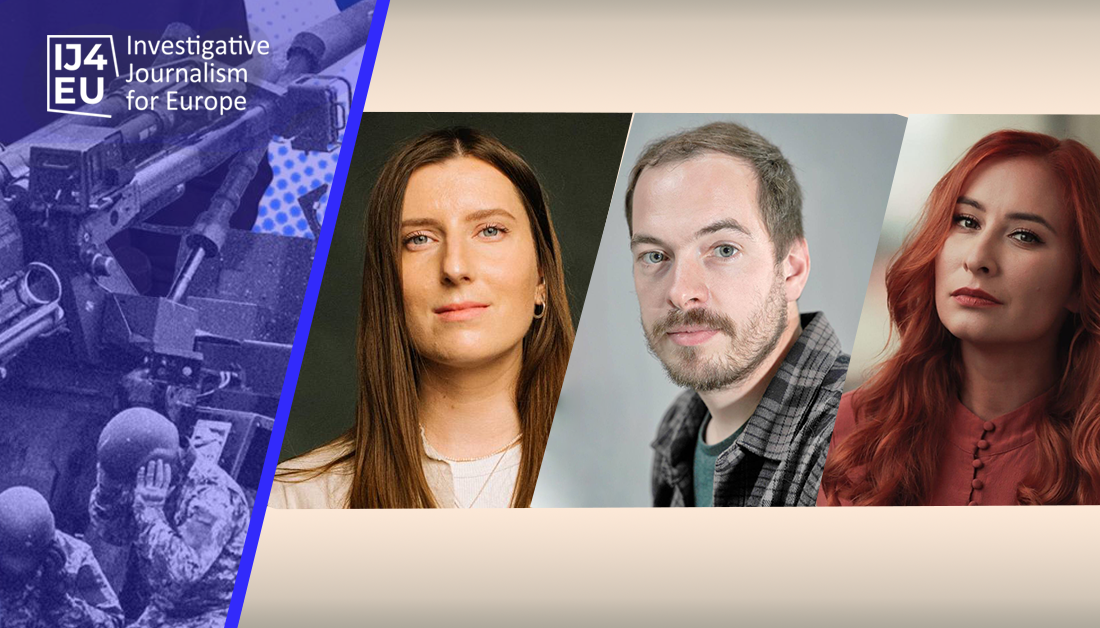By Tea Rissanen
Since Russia’s full-scale invasion in 2022, ammunition shortages have plagued Ukrainian forces. The European Union has delivered roughly half the number of large-calibre artillery shells it agreed to send Ukraine and has promised to ramp up production. EU officials have announced plans to produce 1.7 million 155mm artillery shells by the end of 2024.
However, after months of investigation, a cross-border team of journalists has found that the bloc’s actual production capacity is only about one-third of this target.
The 11-member team behind Absent Ammo, an investigation supported by a €48,500 grant from IJ4EU, spoke to numerous sources, including ammunition producers, government officials, policy advisers and defence experts. What they found was alarming.
Some of the journalists had previously collaborated on another IJ4EU-supported investigation, At War Without Ammo, which exposed the inner workings of European arms procurement.
Laurens Groeneveld, a journalist at The Investigative Desk in the Netherlands who led the project, said the latest investigation began when the reporters noticed high-ranking officials warning of the possibility of the war spreading in the second half of 2023.
“We knew from our previous collaboration project, ‘At War Without Ammo’, that the EU had struggled to supply Ukraine with the promised amount of ammunition,” he told the International Press Institute (IPI) in an interview. “We began to question whether Europe has the capacity to support Ukraine while simultaneously maintaining its own stockpiles.”
Getting concrete figures was challenging. So was estimating the level of stock needed to defend Ukraine and keep Europe safe. NATO requires that every member nation has enough armaments for 30 days of high-intensity war. The specific amount depends on the country, but sources agreed that only a couple met the requirement.
Navigating secrecy
Groeneveld realised he would require a bigger team than the one that carried out “Absent Ammo” due to the need for journalists based in countries with weapons manufacturers or where Russian aggression was the biggest threat.
Two journalists joined to give the Ukrainian perspective: Anna Myroniuk and Valeriya Yegoshyna, both from Schemes, the investigative arm of the Ukrainian Service of Radio Free Europe/Radio Liberty.
Yegoshyna told IPI their first step was to visit the front lines to assess the ammunition situation and to contact state agencies responsible for production. All three journalists said securing sources was difficult at the beginning. The topic is sensitive and different EU countries have different laws on what is public information.
“Some countries classify artillery and specific numbers as operational secrets because they might impact an active battlefield,” Groeneveld said.
In Ukraine, martial law further restricts access to certain information.
“This made it challenging for us to convince sources to share what they knew,” Yegoshyna said. “We argued that it was in the public interest, as the amount of supplies impacts the Ukrainian Armed Forces’ ability to defend the country. We believe that people had the right to know this, so we worked hard to persuade our sources, and ultimately, we succeeded.”
According to Groeneveld, something shifted during the investigation. While many companies were initially reluctant to speak to journalists, over time the team secured interviews with almost all the major producers in Europe. In the end, several off-the-record sources came through and the team could draw conclusions.
“Some industry sources were almost frustrated with the numbers published by the European Commission, insisting they didn’t reflect reality,” Groeneveld said.
Why don’t the numbers add up?
The journalists struggled to explain why the European Union is so bullish about its ammunition production capacity when the reality seems to suggest otherwise. The optimism may be about projecting power, as the EU might not want to expose any potential weakness to Russia, they speculated.
Myroniuk and Yegoshyna said the EU and its member states, even at the highest levels of leadership, sometimes lack the technical and professional understanding required to build up such a complex and technologically advanced production system, and thus at times overpromise.
“Some officials see this issue as merely a matter of money and political will,” Myroniuk said.
For Groeneveld, another factor might be how companies that produce artillery ammunition handle their external communication.
“Public statements about production capacity are often based on expected figures, and some companies set these estimates quite high,” he said.
Furthermore, politicians mostly sign manufacturing contracts that span only a few years, which limits the arms industry’s willingness to invest in large-scale capacity building. Long-term contracts are necessary to ramp up the production and maintain adequate ammunition stockpiles. That means the current approach does not suffice.
Future implications
The importance and impact of the investigation lie in challenging the political narrative and providing the public with essential information, the journalists said. The subject is largely underreported, despite its significant implications for the war in Ukraine, Myroniuk noted.
And if the military experts warning about the war spreading are to be believed, a slow ramping up of ammunition production could have even greater consequences for Europe in the future.
“These organisations obviously want to project a positive image, partly for security reasons,” Groeneveld said. “But if we start discussing the possibility of a larger-scale war, it is in the interest of European citizens to have a realistic vision of what to expect. If the governments start making comments about preparing citizens for a reality where peacetime is over, they also need to be honest about the strength of the army.”
He added that while investigative stories on shell production might not attract the widest audience, they could spark discussion among the people who matter—politicians and those within the weapons industry.
The “Absent Ammo” team includes journalists from Schemes (RFE/RL) in Ukraine, Die Welt in Germany, Investigace.cz in the Czech Republic, Vsquare and Frontstory.PL in Poland, Iltalehti in Finland, the Investigative Center of Jan Kuciak in Slovakia, Delfi in Estonia and The Investigative Desk in the Netherlands.
The findings of the investigation were published in nine languages in July 2024.
- For more on this investigation, see Absent Ammo.
